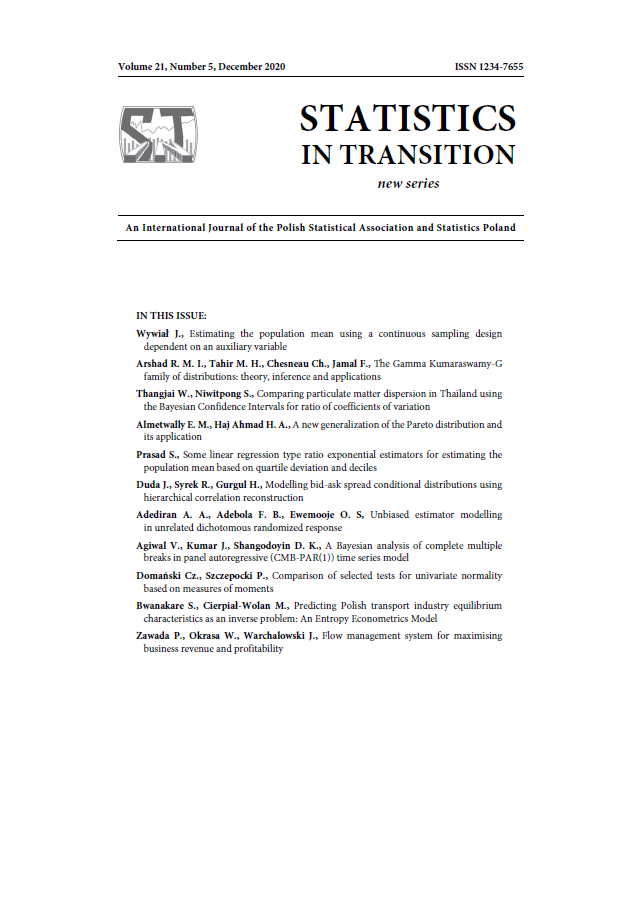ARTICLE
ABSTRACT
While we would like to predict exact values, the information available, being incomplete, is rarely sufficient - usually allowing only conditional probability distributions to be predicted. This article discusses hierarchical correlation reconstruction (HCR) methodology for such a prediction using the example of bid-ask spreads (usually unavailable), but here predicted from more accessible data like closing price, volume, high/low price and returns. Using HCR methodology, as in copula theory, we first normalized marginal distributions so that they were nearly uniform. Then we modelled joint densities as linear combinations of orthonormal polynomials, obtaining their decomposition into mixed moments. Then we modelled each moment of the predicted variable separately as a linear combination of mixed moments of known variables using least squares linear regression. By combining these predicted moments, we obtained the predicted density as a polynomial, for which we can e.g. calculate the expected value, but also the variance to determine the uncertainty of the prediction, or we can use the entire distribution for, e.g. more accurate further calculations or generating random values. 10-fold cross-validation log-likelihood tests were conducted for 22 DAX companies, leading to very accurate predictions, especially when individual models were used for each company, as significant differences were found between their behaviours. An additional advantage of using this methodology is that it is computationally inexpensive; estimating and evaluating a model with hundreds of parameters and thousands of data points by means of this methodology takes only a second on a computer.
KEYWORDS
machine learning, conditional distribution, bid-ask spread, liquidity
JEL
C49, C58, G15
REFERENCES
ABDI, F., RANALDO, A., (2017). A simple estimation of bid-ask spreads from daily close, high, and low prices. The Review of Financial Studies 30(12), pp. 4437–4480
AMIHUD, Y., (2002). Illiquidity and stock returns: cross-section and time-series effects. Journal of Financial Markets 5(1), pp. 31–56
ARMITAGE, S, BRZESZCZYN´ SKI, J., SERDYUK, A., (2014). Liquidity measures and cost of trading in an illiquid market. Journal of Emerging Market Finance 13(2), pp. 155– 196
BE¸DOWSKA-SO´ JKA, B., ECHAUST, K., (2019). Commonality in Liquidity Indices: The Emerging European Stock Markets. Systems 7(2), pp. 7–24
BESSEMBINDER, H., (2003). Issues in assessing trade execution costs. Journal of Financial Markets 6(3), pp. 233–257
BUTLER, A. W., GRULLON, G., WESTON, J. P., (2005). Stock market liquidity and the cost of issuing equity. Journal of Financial and Quantitative Analysis 40(2), pp. 331–348
CHAN, L. K., LAKONISHOK, J., (1993). Institutional trades and intraday stock price behavior. Journal of Financial Economics 33(2), pp. 173–199
CHEN, X., LINTON, O., YI, Y., (2017). Semiparametric identification of the bid–ask spread in extended Roll models. Journal of Econometrics 200(2), pp. 312–325
CHRISTIE, W. G., SCHULTZ, P. H., (1994). Why do NASDAQ market makers avoid oddeighth quotes? The Journal of Finance 49(5), pp. 1813–1840
CORWIN, S. A., SCHULTZ, P., (2012). A simple way to estimate bid-ask spreads from daily high and low prices. The Journal of Finance 67(2), pp. 719–760
DUDA, J., (2018). Exploiting statistical dependencies of time series with hierarchical correlation reconstruction. arXiv preprint arXiv:180704119
DUDA, J., (2019). Parametric context adaptive Laplace distribution for multimedia compression. arXiv preprint arXiv:190603238
DUDA, J., SZULC, A., (2018). Credibility evaluation of income data with hierarchical correlation reconstruction. arXiv preprint arXiv:181208040
DUDA, J., SYREK, R., GURGUL, H., (2019). Modelling bid-ask spread conditional distributions using hierarchical correlation reconstruction. arXiv preprint arXiv:191102361
FONG, K. Y., HOLDEN, C. W., TRZCINKA, C. A., (2017). What are the best liquidity proxies for global research? Review of Finance 21(4), pp. 1355–1401
GAJEWSKI, J. F., GRESSE, C., (2007). Centralised order books versus hybrid order books: A paired comparison of trading costs on NSC (Euronext Paris) and SETS (London Stock Exchange). Journal of Banking & Finance 31(9), pp. 2906–2924
GURGUL, H., MACHNO, A., (2016). Modeling dependence structure among European markets and among Asian-Pacific markets: a regime switching regular vine copula approach. Central European Journal of Operations Research 24(3), pp. 763–786
GURGUL, H., MACHNO, A., (2017). The impact of asynchronous trading on Epps effect onWarsaw Stock Exchange. Central European Journal of Operations Research 25(2), pp. 287–301
GURGUL, H., SYREK, R., (2019). Dependence Structure of Volatility and Illiquidity on Vienna and Warsaw Stock Exchanges. Finance a Uver: Czech Journal of Economics & Finance 69(3), pp. 298–321
HANSCH, O., NAIK, N. Y., VISWANATHAN, S., (1999). Preferencing, internalization, best execution, and dealer profits. The Journal of Finance 54(5), pp. 1799–1828
HUANG, R. D., STOLL, H. R., (1996). Dealer versus auction markets: A paired comparison of execution costs on NASDAQ and the NYSE. Journal of Financial Economics 41(3), pp. 313–357
LESMOND, D. A., OGDEN, J. P., TRZCINKA, C. A., (1999). A new estimate of transaction costs. The Review of Financial Studies 12(5), pp. 1113–1141
MESTEL, R., MURG, M., THEISSEN, E., (2018). Algorithmic trading and liquidity: Long term evidence from Austria. Finance Research Letters 26, pp. 198–203
NAIK, N. Y., YADAV, P. K., (2003). Trading costs of public investors with obligatory and voluntary market-making: Evidence from market reforms. In: EFA 2003 Annual Conference Paper, 408
REISS, P. C., WERNER, I. M., (1996). Transaction costs in dealer markets: Evidence from the London Stock Exchange. In: The Industrial Organization and Regulation of the Securities Industry, University of Chicago Press
ROLL, R., (1984). A simple implicit measure of the effective bid-ask spread in an efficient market. The Journal of Finance 39(4), pp. 1127–1139
STOLL, H. R., (2000) Presidential address: friction. The Journal of Finance 55(4), pp. 1479–1514
